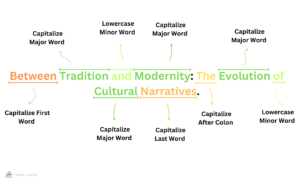How to use Titles in the MLA Style
- Hannah Berry (Ph.D.)
- Published on 11/24/2023
- Updated on12/12/2023
This article aims to provide a detailed guide of MLA title guidelines, offering insights into the effective use of titles in sources such as books, webpages, journals, and articles. By delving into the systematic application of title case, lowercase usage, and specific exceptions.
- Title Case: Capitalize the first, last, and major words, including those following hyphens and after a colon in subtitles.
- Lowercase Rules: Keep prepositions, and coordinating conjunctions in lowercase, except capitalize ‘A’ if it’s the first word.
- Connecting Words: Maintain lowercase for common connecting words, ensuring a consistent appearance in the MLA style.
- Subtitle Exception: Capitalize the first word in a subtitle for consistency in MLA title formatting.

UNDERSTANDING TITLE CASE IN THE MLA STYLE
Title case in the MLA style follows specific rules. Start with the capitalization of the first word of the title, the last word, and all principle words including those that follow hyphens in compound terms such as nouns, pronouns, verbs, adjectives, adverbs, subordinating conjunctions.
| SOURCE TYPES | EXAMPLES |
| Book Title: | The Grapes of Wrath. |
| Website Title: | National Geography. |
| Webpage Title: | “A Comprehensive Guide to Exploring Quantum Physics.” |
| Journal Title: | Journal of Biological Chemistry. |
| Article Title: | “The Impact of Social Media on Contemporary Politics.” |
Refer to the MLA format page for formatting guidelines to use for different types of titles and and use the MLA citation generator to create citations. Explore a range of features offered by TypeCite’s citation machine, including cite journals in APA, as well as APA book citations and APA webpage generator.
RULE FOR CAPITALIZING SUBTITLES
When a subtitle is introduced by a colon, question mark, full stop, em dash, or exclamation mark, the first word is also capitalized.
| SOURCE TYPES | EXAMPLES |
| Book Title: | The History of Ancient Rome: A Timeless Exploration. |
| Website Title: | What are Genetics? An In-Depth Study of DNA. |
| Webpage Title: | “Exploring New Horizons! A Guide to Space.” |
| Journal Title: | History — The Truth at Last. |
| Article Title: | “Exploring Health Benefits of Meditation: An Evidence-Based Approach.” |
 |
Avoid Unnecessary Capitalization: While adhering to title case, do not capitalize every word, especially minor words like prepositions and coordinating conjunctions, unless they are the first or last words. Hyphens and Capitalization: Extend capitalization to words that follow hyphens in compound terms within the title. Mindful Punctuation: Pay attention to punctuation within titles, capitalization even after punctuation marks such as question marks or exclamation points. |
HOW TO USE LOWERCASE FOR MINOR WORDS
Following MLA title rules means keeping prepositions and coordinating conjunctions, often classified as minor words in lowercase. Words such as ‘a’, ‘an’, and ‘the’ are always written in lowercase. This also applies to common connecting words like ‘and’ and ‘but’.
One thing to remember is that the word ‘a’ is written in lowercase unless it is the first word of the title.
| SOURCE TYPES | EXAMPLES |
| Book Title: | A Study on the Effects of Climate Change. |
| Website Title: | The Significance of Art in Society: An In-Depth Analysis. |
| Webpage Title: | “Exploring the Interplay Between Science and Ethics.” |
| Journal Title: | Educational Psychology Review: Strategies for Effective Learning. |
| Article Title: | “Fitness Fundamentals: Building a Stronger and Healthier You.” |
This includes terms such as ‘and’, ‘to’, ‘for’, ‘in’, ‘at’, ‘on’, ‘of’, ‘with’, ‘but’, ‘against’, ‘between’, ‘nor’, ‘so’, ‘yet’, ‘if’, ‘by’, ‘off’, ‘per’, ‘up’, and ‘via’. This practice underscores the commitment to a standardized and consistent appearance of titles in accordance with the MLA style.
GIVE YOUR CITATIONS A BOOST TODAY
Start your TypeCite Boost 3 day free trial today. Then just $4.99 per month to save your citations, organize in projects, and much more.
SIGN UPThrough a nuanced understanding of title case usage, including the capitalization of major words and the consistent rendering of minor words in lowercase, writers contribute to the overall clarity and uniformity expected in scholarly discourse.